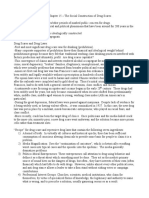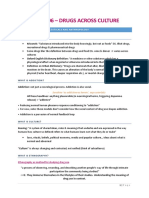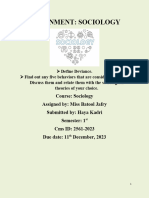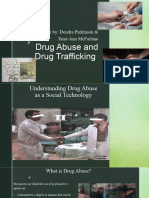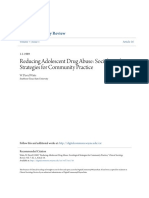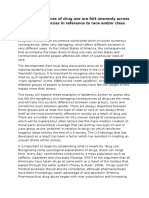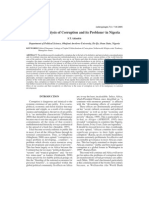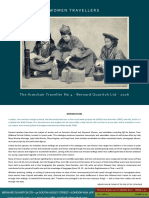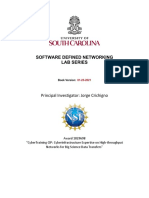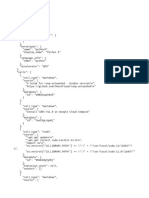Sociological Reflection on the Course Lectures
Avani Dhar
Student Number: 37950722
Instructor: Dr. Dan Small, PhD
Soci 387: The Sociology of Drugs
Due Date: 19 August 2021
1
�Lecture Reflection One: Small, Dan. 2021. “Entering the Moral Minefield: Introduction to a
Sociocultural and Narrative Framework for Examining Drugs and Drug Use: What Are Drugs?”
SOCI 387 Lecture: Sociology of Drugs. University of British Columbia. July 6
Summary: The first lecture signifies the necessity of sociology in the study of drugs. Small
(2021) suggests that the social variables attached to the consumption and addiction of drugs are
often sidelined when examining drug use. By approaching drug epidemics as issues of criminal
justice, governments dismiss the cultural narratives that have shaped drugs and society.
"Committing sociology" here not only helps dismantle the demography of drug use, but also
intersects the 'self' with society (Small, 2021). Individual drug use as a result of socio-historic
factors demonstrate how cultural narratives can directly affect one person. This lecture expounds
on the foundation of sociology as a discipline to understand the formation of drug laws, and its
application in the real world through public or "outlaw" sociology that embeds research at the
ground level (Small, 2021).
Personal learning outcomes: Discovering that "early narcotic legislation in Canada was racist
in its intent" was not a shocker, however, it opened my eyes to the intersectionality of race and
drug abuse (Small, 2021). Racist laws that criminalize substances creates a vicious cycle of
stigma, that causes oppression of disenfranchised peoples, which is further institutionalized by
the strengthening of such laws, worsening the situation of drug users.
Contemporary connection: This lecture closely resonates to a CBC radio podcasting
connecting drugs to the history of racism in Canada. Jeff Turner (2017), on his show 'On Drugs'
explains how drugs were used as props to justify racially discriminatory policies. This can be
directly linked to the construction of race as a social and scientific concept. The rationalization of
2
�racial differences through drug consumption patterns justified prejudice and stigmatization of
racialized groups in Canada. To uncover such a phenomenon is why we need sociology, it
examines the socio-cultural factors that gave birth to racist laws.
3
�Lecture Reflection Two Small, Dan. 2021. “Dopamine, Dope and Demons: Addiction and
Aetiology” SOCI 387 Lecture: Sociology of Drugs. University of British Columbia. July 8
Summary: In the context of theoretical conceptualization of addiction, Small (2021) in his
second lecture expounds on the psycho-social theories associated with drug use. Accounting the
methodology to study addiction, Small (2021) proposes auto-ethnography to be an effective tool
to analyze addiction. By embedding the researcher into the social setting, auto-ethnography
examines the social actors at play, because their individual actions give meaning to the
phenomenon, what Sutherland refers to as symbolic interactionism (Small, 2021). Moreover, this
lecture provides insights into psychological theories postulated by a leading addiction scholar
Bruce Alexander (Small, 2021). His ground-breaking theory on the psycho-social dislocation of
an individual as the determining factor of addiction transformed the modern understanding of
this issue. Moreover, Alexander holds a free-market society responsible for producing an
individualistic form of living that "undermines commitment to others" (Small, 2021). This not
only isolates an individual to seek drugs for solace, but also prevents them from seeking help.
The employment of these psycho-social theories helps uncover the reality behind "manufactured
truths", because the naturalization of "facts about addiction are a barrier to social change" (Small,
2021).
Personal Learning outcome: The previously mentioned point made by Small (2021) acquired
from Bruce Alexander regarding the lack of awareness of "manufactured truths" explains to me
the dynamism of social facts. Ten years ago, people were arrested and highly stigmatized for
smoking marijuana, now the Cannabis industry is worth billions of dollars (Intrado, 2021).
Society is constantly changing narratives attached to a 'manufactured truth', and it is pertinent to
4
�recognize this feature, because drug abuse is indeed a socially constructed reality, formed as a
result of intersecting socio-cultural variables.
Contemporary Connection: David Nutt's (2017) TedTalk on benefits of drugs, focusing on
psychedelic research preventing brain diseases like Alzheimer's, PTSD, addiction, and
depression demonstrates a resurgence in the study of psychedelics. Psychedelics came under
schedule one narcotics decades ago, now they are used for psychotherapy to cure depression. The
construction of truth pertaining to psychedelic use has seen a drastic change, this shift from an
illicit drug to a major tool for harm reduction shows how dynamic societal narratives can be.
5
�Lecture Reflection Three: Small, Dan. 2021 “Sociological Theories of Drug Use” SOCI 387
Lecture: Sociology of Drugs. University of British Columbia. July 13
Summary: What does it mean to be the product of the system? This lecture covers questions that
challenge the structure of society; the structure responsible for producing, demonizing and
ostracizing drug users. Small (2021) promotes an evidence based sociological blueprint for the
examination of drugs and society. Investigating the construction and engineering of socio-
cultural narratives about drugs and users, a sociological blueprint employs Mills' sociological
imagination uncovering the causes, correlations, and impacts of certain phenomena (Small,
2021). Moreover, this lecture introduces the pioneers of early theoretical thought pertaining to
drug use. Lindsmith argues for objective evidence-based research, condoning moralistic
perspectives that characterize users as social misfits (Small, 2021). Additionally, presenting a
Durkheimian approach, Merton introduces the notion of reflexivity, a method that brings
subjectivity into research (Small, 2021). Unlike Lindsmith, it incorporates a moral and evidence-
based perspective to study drugs, because values attached to a phenomenon are the defining
feature of its institutionalization.
Personal Learning outcome: The most intriguing point made by Small (2021) in my belief was
the significance of sociological accounting. Accounting of the repercussions of sociological
forces upon the lives of drug users is the essence of objective research, data (qualitative or
quantitative) is the indispensable tool for drawing inferences that push people to addiction. For
example, an indigenous woman affected by structural forces such as lack of access to
counselling, poor education, food scarcity, etc. can be responsible for her dependency on alcohol.
This hypothesis derived from sociological accounting can further be strengthened by
6
�ethnography, thus employing public scholarship or outlaw sociology to make sense of social
issues and find ways to combat it.
Contemporary Connection: Vice (2021) channel's investigation into CIA's involvement in the
crack cocaine epidemic is an evident explanation into structural forces that determine the fate of
marginalized communities. Post-civil rights movements American society increasingly
stigmatized Black American drug users, leading to high rates of incarceration (Vice, 2021). Vice
(2021) uncovers how the CIA supplied crack to Black dealers in the 80s, while leading the war
on drugs. We need sociology to de-construct such a phenomenon, to understand the racist intent
behind these actions, and work on reconciliation.
7
�Lecture Reflection 4: Small, Dan. 2021. “Sociological Exploration of Illicit Drug Use in
Relation to Harm Reduction: The Intersection of Population Health and Society” SOCI 387
Lecture: Sociology of Drugs. University of British Columbia. July 15
Summary: After declaring a public health emergency in 1997, Vancouver opened itself to a new
and effective ways to combat drug abuse related deaths and diseases (Small, 2021). This lecture
uses Vancouver's health crisis as a case study to showcase the success harm reduction services
have achieved. Small (2021) operationalizes harm reduction as the literal reduction of harm, that
does not necessarily denounce risky behaviour, but in the long run can make substantial changes,
because we need drug users to be alive for treatment. Supervised injection sites being the
pioneering case in the effectiveness of this methodology; provides a safe and supervised space
for users (Small ,2021). Through the examination of different approaches of harm reduction, this
lecture accounts the bureaucratic hinderances faced in the inauguration of HR services (Small ,
2021). In the end, it was community-based research strategies such as distribution of NARCAN
or Crack Kit that provided basic rights to users and showed opposing parties that a safe space
with people who care can make a huge difference in the prevention of overdoses and spread of
diseases (Small ,2021).
Personal Learning outcome: Small (2021) maintains that harm reduction is "deeply cultural in
nature", it is indeed a controversial approach as it does not promote abstinence. However,
viewing it as a matter of criminal justice only causes more death and suffering, impacting every
fabric of society, young children have lost their parents to jail cells over possession of illegal
8
�drugs, but people continue to applaud military like operations to fight drugs. We have to
recognize that criminalization only institutionalizes stigma, but harm reduction saves lives.
Contemporary Connection: Lyndsay Hartman (2019) in her TedTalk addressing their harm
reduction program, defines it as an "act of compassion". By approaching the topic in a value-
based, moral, humanistic sense, they appeal to the emotions of people that help pass sanctions to
legalize such programs (Hartman, 2019). They indulge in public scholarship, as their less
theoretical way of addressing this issue can be very helpful to make this topic a public
discussion, because not everyone comes from educated backgrounds to understand the nuances
of drug use.
9
�Lecture Reflection Five: Small, Dan. 2021. “Sociocultural Approaches to the Study of Drugs in
relation to Homelessness, Housing and Stigmatized Communities” SOCI 387 Lecture: Sociology
of Drugs. University of British Columbia. July 20
Summary: Homelessness is a social issue we cannot hide from, we see it walking down the
street, we hear its consequences on the news, this lecture addresses this very seen problem in our
society (Small, 2021). Homelessness for the drug dependent has worse repercussions. 69 percent
of homeless in Metro Vancouver face addiction (Small, 2021). Small (2021) by the means of
sociological accounting analyzes different approaches applied to resolve this issue. He examines
the housing first model, that requires users to be abstinent before providing housing, and infers
the master narratives associated with such a model (Small, 2021). Subsequently, the housing first
model that allows users housing before attaining abstinence is a strategy of harm reduction that is
more effective in reaching goals. By revealing the implicit and explicit values pertaining to
housing models, its influence on shaping the collective understanding of drug dependent
homelessness can be determined (Small, 2021).
Personal Learning outcome: Drawing from the facts presented in the lecture, I believe the latter
model to be the answer to drug dependent homelessness. Not only does it provide a safe space
for a user to start their journey of abstinence, but also alleviates cultural harm, by concealing
their use, preventing them from stigmatization.
Contemporary Connection: I recently stumbled upon an article from the UBC department of
sociology (2021), that applauds a group of students for a project on homelessness in Strathcona
Park. These students tackled problems associated with lack of amenities in the homeless
10
�encampment during the COVID-19 pandemic and provided recommendations.
Recommendations included, providing heating, sanitation, etc., their work is a great example of
public scholarship, they engaged with an indigenous matriarch, spoke to the residents of the
encampment to propose effective changes. This demonstrates how sociology's evidence-based
accounting can not only provide hold parties responsible for issues, but also offer effective ways
to combat it.
11
�Lecture Reflection Six: Small, Dan. 2021.” The Socioeconomics of Drug Use: Poverty and
Precarious Employment: (Sociology and Social Enterprise: East Van Roasters Chocolate Shop
for Women in Recovery)” SOCI 387 Lecture: Sociology of Drugs. University of British
Columbia. July 22
Summary: This lecture explores the Employment Continuum that bounds the life of drug users.
Drug use can have considerable health, social, economic and environmental costs on individuals
and society (Small, 2021). Small (2021) explores the barriers of employment that include lack of
stability, homelessness can bring about this instability, where people have no phones or ids that
deprive them from vocational job and often reduce them to traditional jobs. Weber would
characterize such a phenomenon as social closure, where individuals are closed off from
opportunities (Small, 2021). The lecture moves forward to explain the socio-spiritual power of
employment, because more than providing shelter and a hot meal, financial stability can facilitate
a healing journey for suers that have experienced social exclusion (Small, 2021). Moreover,
Small (2021) provides a success case study of a Downtown Eastside program called the East
Vancouver’s Roasters social enterprise located under a treatment-based housing project aimed to
provide dignified employment to promote stability in the lives of users, inturn facilitating the
elimination of drugs (Small, 2021).
Personal Learning outcom: Small (2021) introduces the idea of sociological intentionality
referring to this project, that employs a proud historical symbol to alleviate a community’s
esteem. One of the most compassionate initiative I've heard of to help a deprived and isolated
community. Coming from Mumbai, India, that hols Asia's largest slum, I've noticed how these
'ghettoized' communities are excluded from mainstream society by narratives that demean the
12
�community. Such an initiative in my hometown would make a huge difference in how slums or
viewed from the outside as well as from the inside.
Contemporary Connection: “Great Leaders Do What Drug Addicts Do”, Brody-Waite (2018),
a former addict, opens up about his struggle from addiction to abstinence to becoming the CEO
of a firm. He recounts his perseverance as an addict to control his dependency, his familiarity
with physiological and psychological discomfort pushed him to do the hard work that led him to
become a leader. His story is an example of sociological intentionality but for a single individual,
he employed the values he learned as a ‘social leper’ to go up the social ladder. It is a brilliant
story of success that can be motivation to other users.
13
�Lecture Reflection Seven: Small, Dan. 2021. “Structural Impact of Societal Approaches to
Drug Use: The War on Drugs, Racialization and Mass Incarceration” SOCI 387 Lecture:
Sociology of Drugs. University of British Columbia. July 27
Summary: This lecture covers the grim consequences of the war on drugs (Small, 2021). Small
(2021) provides an overview of the harsh drug laws that criminalized possession and
consumption of illicit drugs in the US, causing mass incarceration among racialized
communities. Subsequently, these drug laws and narratives surrounding drugs influenced global
policy (Small, 2021). The lecture moves forward to introducing Drucker's conceptualization of
mass incarceration as an epidemic that resulted in the innumerable years of life lost, crippling
communities and disrupting the social fabric of American society that continues to show impacts
till this day (Small, 2021). Moreover, the domestic impact of harsh drug laws seems to have the
same racist roots as America (Small, 2021). Anti-Chinese sentiments led to the inauguration of
The Opium Act in the early twentieth century (Small, 2021). This demonstrates the sociological
gears of society at play, the structure violence against marginalized peoples such Indigenous,
Chinese and Black was manifested via these laws. We conclude the lecture by discussing the
social measures of inequality in the form of foster care systems, which often is considered as the
extension of the colonial residential schools (Small, 2021).
Personal Learning Outcomes: This lecture opened my eyes to ways that impacts of
incarceration can be measured. We often dismiss what the family of a 'criminal' goes through
upon their arrest. The lack of parental guidance for essential years of their lives, a child perhaps
loses faith in the system to help them, and hence sought solace in drugs.
14
�Contemporary connection: The Atlantic's (2015) "mass incarceration, visualized" draws on
data that shows the overrepresentation of Black Americans and hols that more than it is no longer
the incarceration of one individual, but of social groups. This resonates with the social measures
of inequality, the war on drugs were an extension of the Jim Crowe laws, that deprived Black
families of basic human rights. This influence has now struck the rest of the of the world,
Philippines being the best example, where the new governments has openly threatened users of
death if they continued 'breaking the law'.
15
�Lecture Reflection Eight: Small, Dan 2021. “Medical Narratives: The Social Construction of
Drugs as a Medical Object: Addiction Medicine and Pharmaceutically Assisted Therapy” SOCI
387 Lecture: Sociology of Drugs. University of British Columbia. July 29
Summary: Criminalizing drug use does nothing to stop people from using them. This is an
example of a rival narrative employed by the proponent of INSITE, Canada's first safe injection
site (Small, 2021). This lecture uses INSITE as a case study to demonstrate the intersection
between society and drugs (Small, 2021). The inauguration of this initiative was a response to
the epidemiological circumstances of the late 90s. INSITE witnessed numerous hurdles before its
effectiveness due to its relationship with a community that was implicitly "a zone of
abandonment" (Small, 2021). The Downtown Eastside of Vancouver became the socially
constructed lepers due to the addiction rates that were by default considered as correlated to
crime (Small, 2021). This initiative then aimed at removing these barriers as a part of "low
threshold" narrative interventions (Small, 2021). Consequently, the efficiency of INSITE
inspired other provinces to introduce harm reduction strategies as this.
Personal Learning Outcomes: Since I am not from Canada and never witnessed the reality of
the drug overdose epidemic, learning about the public outcry in response to harm reduction
initiative seems normal. Before learning about its benefits, I too would have considered it as a
defeat of the war on drugs and seen it as the backward movement of the progress made. My
paralysis to see things differently roots from the false narratives i grew up learning about drugs.
However, now I see the deprivation of INSITE as a social justice issue.
Contemporary Connection: Guy Felicella (2018), in his TedTalk provides a comparative
perspective to harm reduction relevant to this discussion. He maintains that every field of
16
�medicine employs harm reduction strategies to prevent death, from diabetes to heart problems,
every pill prescribed is to reduce harm. But why do we fall short for addiction? Why is harm
reduction controversial when applied to addiction? In my opinion, it’s the rival narrative to harm
reduction that deprives public knowledge of the physiological consequences of addiction. The
only way to combat it so through public sociology, that includes initiatives involving society as
whole, because addiction is a socially constructed issue, that requires the help of the collective.
17
�Lecture Reflection Nine: Small, Dan. 2021 “Sociological Analysis of North America’s first
Supervised Injection Facility: Social Movements and Public Scholarship” SOCI 387 Lecture:
Sociology of Drugs. University of British Columbia. August 3
Summary: This lecture covers the relationship between enforcement and harm reduction (Small,
2021). Essentially, this lecture holds the criminal justice system as the moral gatekeepers of
values (Small, 2021). The laws and policing practices that govern injection drug use influence
the risk environment for people who inject drugs. They directly influence narratives pertaining to
drug use because street-level policing activities can hinder injection drug users' access to sterile
syringes at SIFs. This lecture develops the story of how changing law enforcement practices
showed substantial improvements in the fight against the drug overdose epidemic (Small, 2021).
Viewing the police as caring safe keepers, what Small (2021) calls police symbolic capital, is a
form of harm reduction, that invited the most wounded and excluded in society to be a part of the
collective.
Personal Learning Outcomes: This initiative in my belief is the most pertinent aspect of harm
reduction, the socio-historic position of the police has been of the 'bad guy' despite what their job
is meant to be. In order to facilitate an environment of healing, the police, as civil servants must
set a standard to teach the society how addiction can be handled with safety and care.
Contemporary Connection: Project Inclusion (2021), an initiative that involves police
interference in the process of harm reduction is a great example that showcases the applicability
of public sociology. They also recount the horrific experiences of users with the RCMP that
caused mistrust in the police. However, this initiative aims at removing such experiences and
providing an inclusive space for users to start their journey of healing.
18
�Lecture Reflection Ten: Small, Dan. 2021. “Enforcement and Harm Reduction: Sociological
Examination of the Transformation of the Role of Police Personnel from Protectors of Public
Safety to Protectors of Public Health)” SOCI 387 Lecture: Sociology of Drugs. University of
British Columbia. August 5
Summary: The second last lecture of the course provides a comprehensive analysis of the main
ideas course covered (Small, 2021). Starting with examining the progress made in Canada since
the first overdose epidemic, Dr. Small reflects on his experience with public sociology,
encountering people he referred to as "everyday philosophers", the intellectuals of the public,
that engage in reflexive thinking and essentially give meaning to what academics aim to do
(Small, 2021). Furthermore, he introduces French scholar of public sociology Latour, that
suggests that science and society cannot be separated, and are bound together by the notion of
research (Small, 2021). Both the disciplines are committed to their scholarship in favour of the
betterment of society. Finally, we conclude the class by discussing the applicability of public
sociology that transforms into structural activism (Small, 2021).
Personal Learning Outcomes: I learned from this lecture and this class as a whole, that
sociology is not merely academic papers. Outlaw sociology's "intentional intersubjectivity"
brings together the academic and the community that can change lives, provide meaning to
unspoken phenomena, and most importantly rebuild community.
Contemporary connection: Vice (2021) Channel’s “The Reality of Legalizing Cocaine, Heroin,
and Ecstasy” investigates how the legalization of illicit drugs can be an extremely transformative
19
�harm reduction strategy, it can prevent accidental overdoses, lacing, etc., Additionally, they also
suggest that legalization under the government is the only option and not under privatized
companies. The government can prevent its glorification unlike companies that aim for profits.
After learning what I have about harm reduction, this seems to be the light at the end of the
tunnel.
20
�References:
Lecture 1:
Turner, Jeff. July, 17, 2017. “Drugs: What's race got to do with it?” CBC Radio.
https://www.cbc.ca/radio/ondrugs/drugs-what-s-race-got-to-do-with-it-1.4206616
Lecture 2:
Intrado Global News Wire. February, 18, 2021. “ The Worldwide Cannabis Industry is Projected
to Reach $90.4 Billion by 2026”.
https://www.globenewswire.com/news-release/2021/02/18/2177949/0/en/The-Worldwide-
Cannabis-Industry-is-Projected-to-Reach-90-4-Billion-by-2026.html
Nutt, David. April, 17, 2017. “How can illegal drugs help our brains” TEDx Talks
https://www.youtube.com/watch?v=WOxSQHtJWlo
Lecture 3:
Vice. August, 17, 2021. “Did the CIA Actually Sell Crack in the 1980s?” Youtube Video.
https://www.youtube.com/watch?v=eE2-zYEldGc
21
�Lecture 4:
Hartman, Lyndsay. October 30, 2019. “Harm Reduction as an Act of Compassion” Tedx Talks.
https://www.youtube.com/watch?v=sUgxnYEA8F0
Lecture 5:
UBC Department of Sociology. February 17, 2021. “UBC Sociology students win the
CityStudio’s People Choice Award for project on homelessness in Strathcona Park” UBC
https://sociology.ubc.ca/news/ubc-sociology-students-win-the-citystudios-people-choice-award-
for-project-on-homelessness-in-strathcona-park/
Lecture 6:
Brody-Waite, Michael. June, 13, 2018. “Great Leaders Do What Drug Addicts Do”. Tedx Talks
https://www.youtube.com/watch?v=UUnRKf2CemA
Lecture 7:
The Atlantic. October, 2, 2015. “Mass Incarceration, Visualized” Youtube.
https://www.youtube.com/watch?v=u51_pzax4M0&t=16s
22
�Lecture 8:
Felicella, Guy. July, 18, 2018. “ I Died Six Times … Let’s End the Stigma of Harm Reduction”
Tedx Talks.
https://www.youtube.com/watch?v=5uQxbh5mSPs
Lecture 9:
PIVOT, 2021. “Project Inclusion: Police Interference with Harm Reduction”
https://www.pivotlegal.org/project_inclusion_police_interference_with_harm_reduction
Lecture 10:
Vice. February 10, 2021. “The Reality of Legalizing Cocaine, Heroin, and Ecstasy”. Youtube
https://www.youtube.com/watch?v=haT4FrOYPtk
23




